

"I am an indigenous woman, and I do not practice FGM"

The first alarm was sounded in 2007, when a newborn Indian girl died after a traditional procedure in which her clitoris was excised. A local official tipped off the national media, and Colombia joined the ranks of countries known to be practising female genital mutilation (FGM).
Behind what generations of indigenous Embera Chami people called “the cure” was a painful reality that many thought to be the exclusive preserve of some African and Southeast Asian countries. Although many Embera see it as a form of purification or cleaning, the cultural significance of female genital mutilation is unclear even to many who practise it.
“Not even the midwives [know]!,” according to local leader Martín Siagama, a member of Indigenous Regional Council of Risaralda (CRIRES) which helped spearhead a long period of self-examination and reflection within the Embera community over the custom.
The baby girl’s death sparked the creation of the “Embera Wera” (“Embera Women”) movement, which, with support from the MDG-Fund, worked to transform the practice of FGM from within the community itself, helping to find an alternative that would replace its meaning within Embera culture without risking the health of its little girls.
According to Siagama of CRIRES, the Embera community’s research revealed that the practice was not traditionally Indian, but rather had been brought over by Europeans more than 500 years ago. As such, says Siagama, it had to be prohibited.
Last month, the Congress of the Embera People ratified the community’s decision to ban FGM throughout the western department of Risaralda and impose fines and penalties on those who practice it.
"I am a woman, I am an Embera and I do not practice female genital mutilation!” says Norfilia Caizales, women’s councillor at CRIRES, repeating the slogan of the campaign. "We have since 2007 been looking for new ways to empower our girls, and it’s time to say “No more!” to the practice of genital cutting.”
Human rights organizations and women’s advocacy groups estimate that between 100 and 130 million women have undergone FGM worldwide. In the case of Colombia, experts believe that three to four Embera girls die each year from complications of the procedure.
The Embera Chami, one of 30 indigenous groups in Colombia in danger of extinction, have historically lived in very vulnerable conditions marked by extreme poverty, exclusion and discrimination.
The most visible result of the “Embera Wera” campaign has been the community's commitment to eradicate FGM, but the programme has also promoted other initiatives to help women gain a place in decision-making processes and to know their rights, such as the creation of a Law School or the holding of the First Congress of Embera Women.
Miriam Nengarabe, an Embera, says that although indigenous women were historically not valued enough in their communities, now, through education and organization, they are beginning to recognize their rights: "Because women are the same as anyone else."
The "Embera Wera" initiative, which works with about 25,000 indigenous women in Risaralda, is supported by the Colombian government and the United Nations Population Fund (UNFPA), and works with indigenous authorities and community members.
It is part of the joint United Nations programme “Integral strategy for the prevention and awareness of all forms of gender-based violence in Colombia”, one of 128 financed by the MDG-Fund worldwide to achieve the Millennium Development Goals of poverty reduction. The programmes focus particularly on women and children, among the most vulnerable and marginalized communities.
For many indigenous women, the “Embera Wera” campaign of Colombia has marked an important step in their empowerment. "We have awakened many women and talked about what was not discussed before. Now women have a say in their lives, we are no longer afraid to speak. We are being trained and learning more and more about our rights as women, says Solany Zapata, another Embera Chami woman who said “No to F
Click here to read about the MDG-F's work in Colombia.
Click here to read other success stories from the MDG-F's work to fight poverty and improve livelihoods around the world.